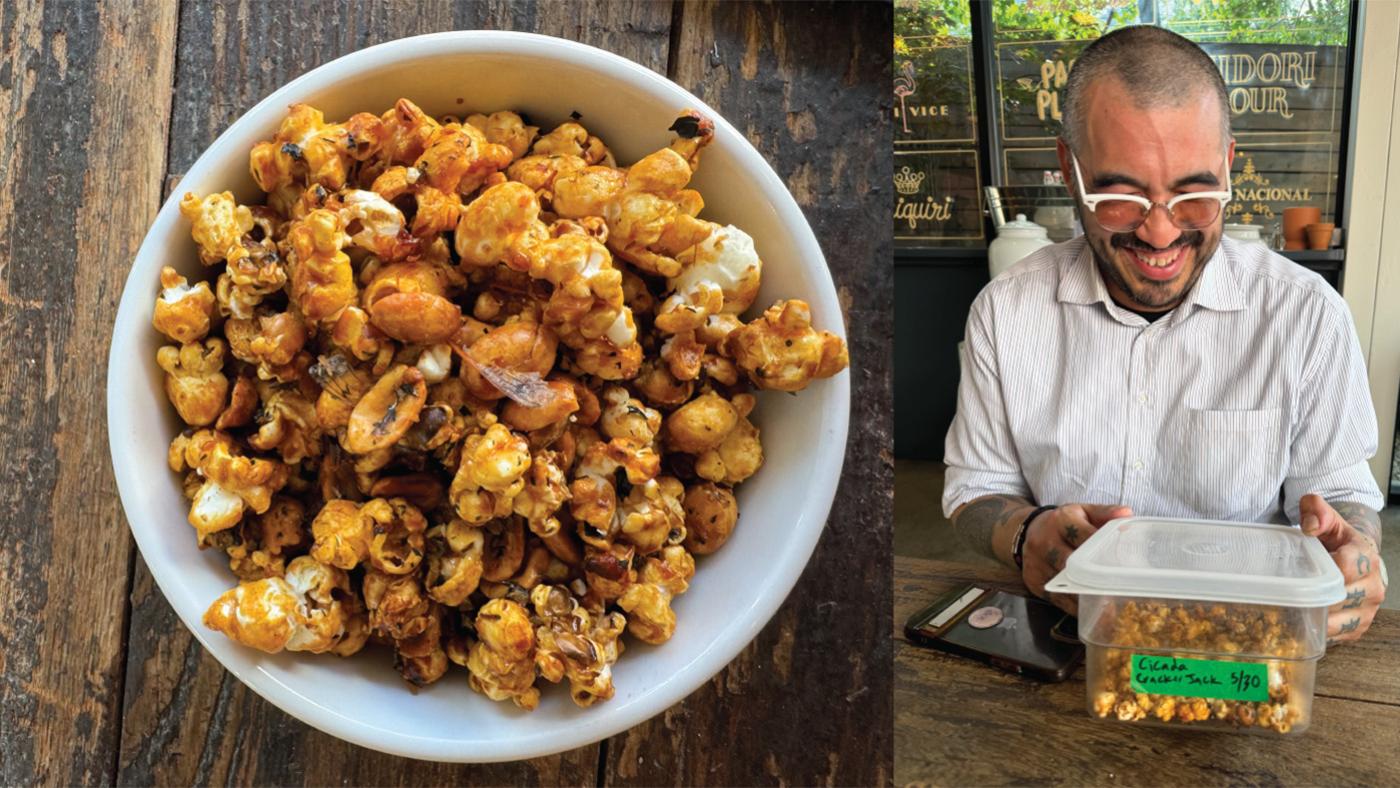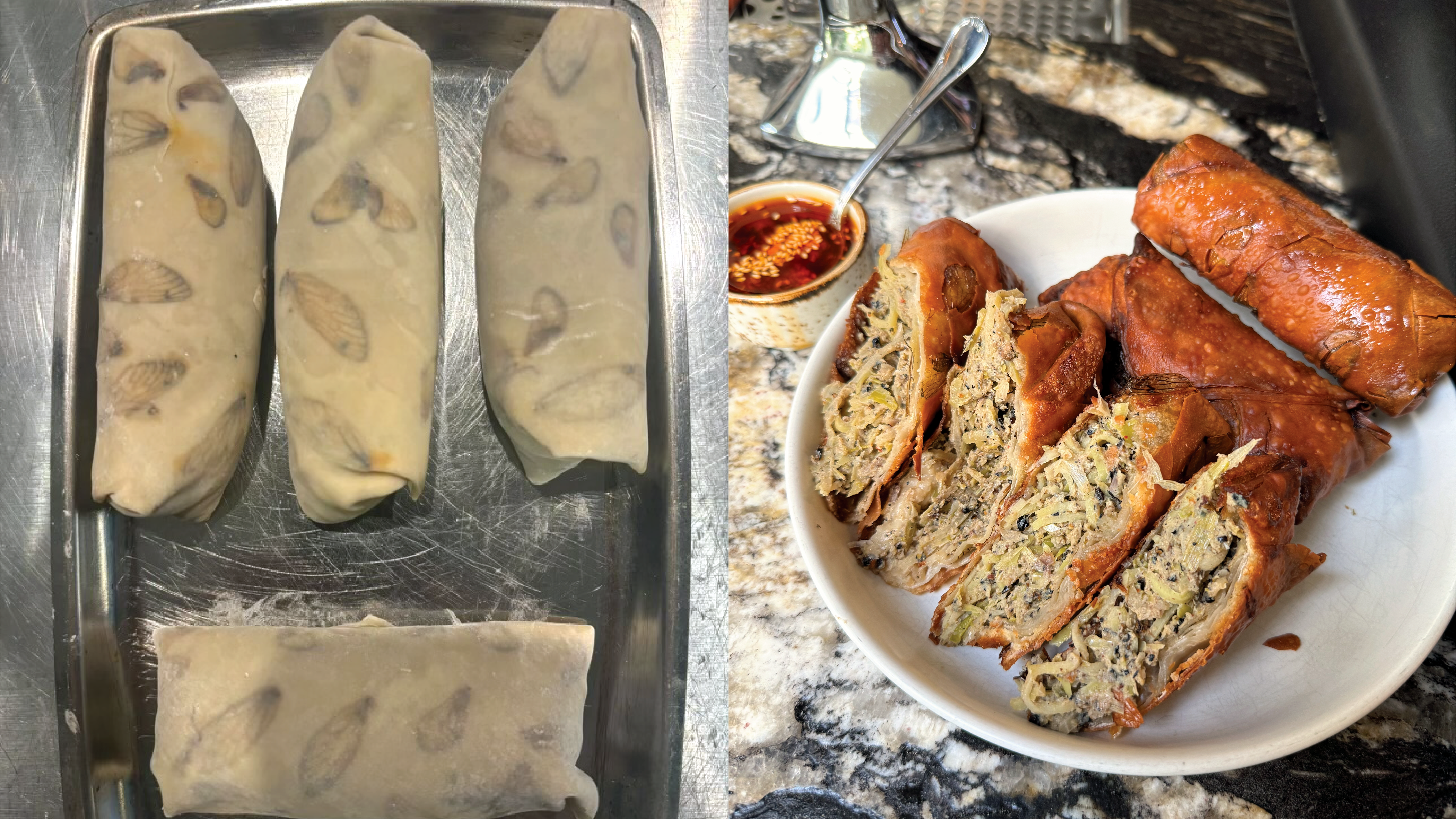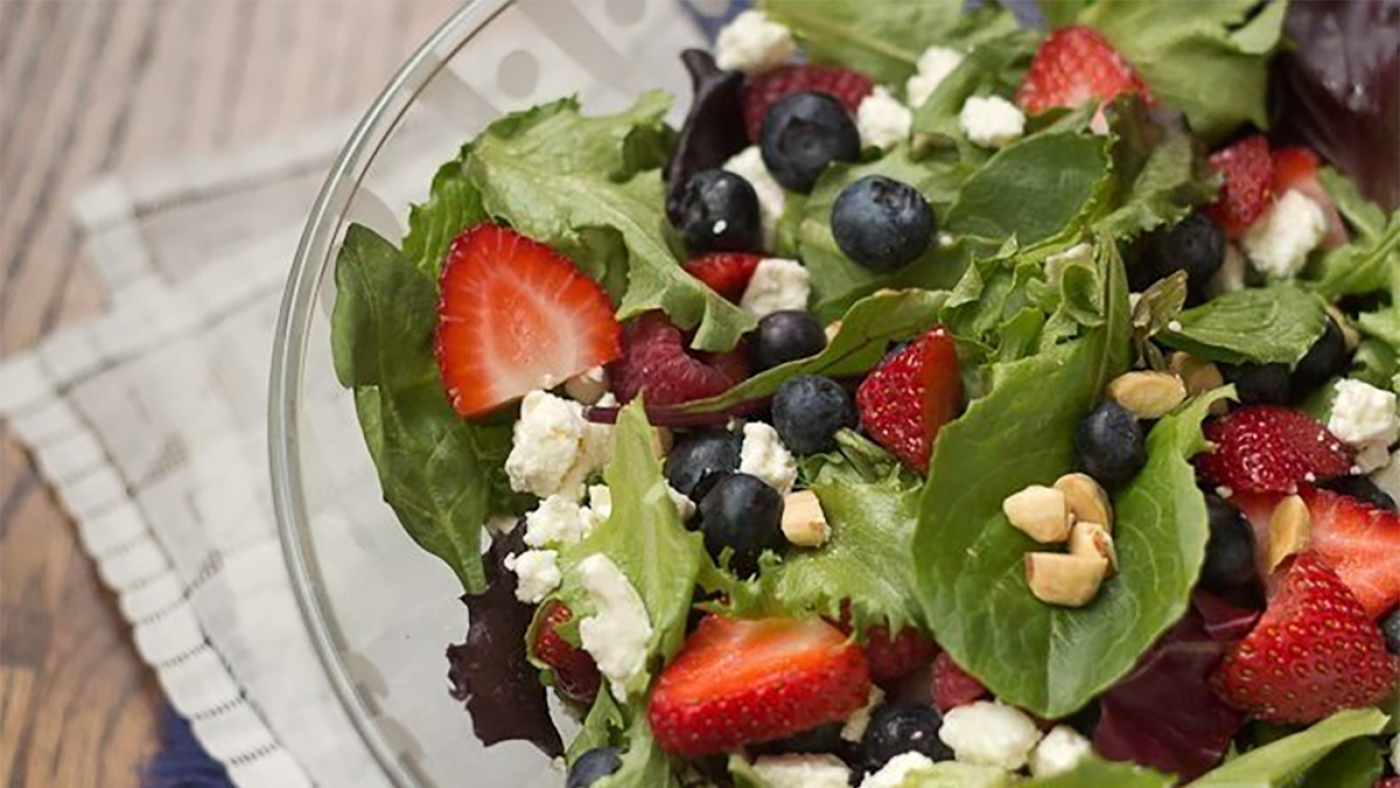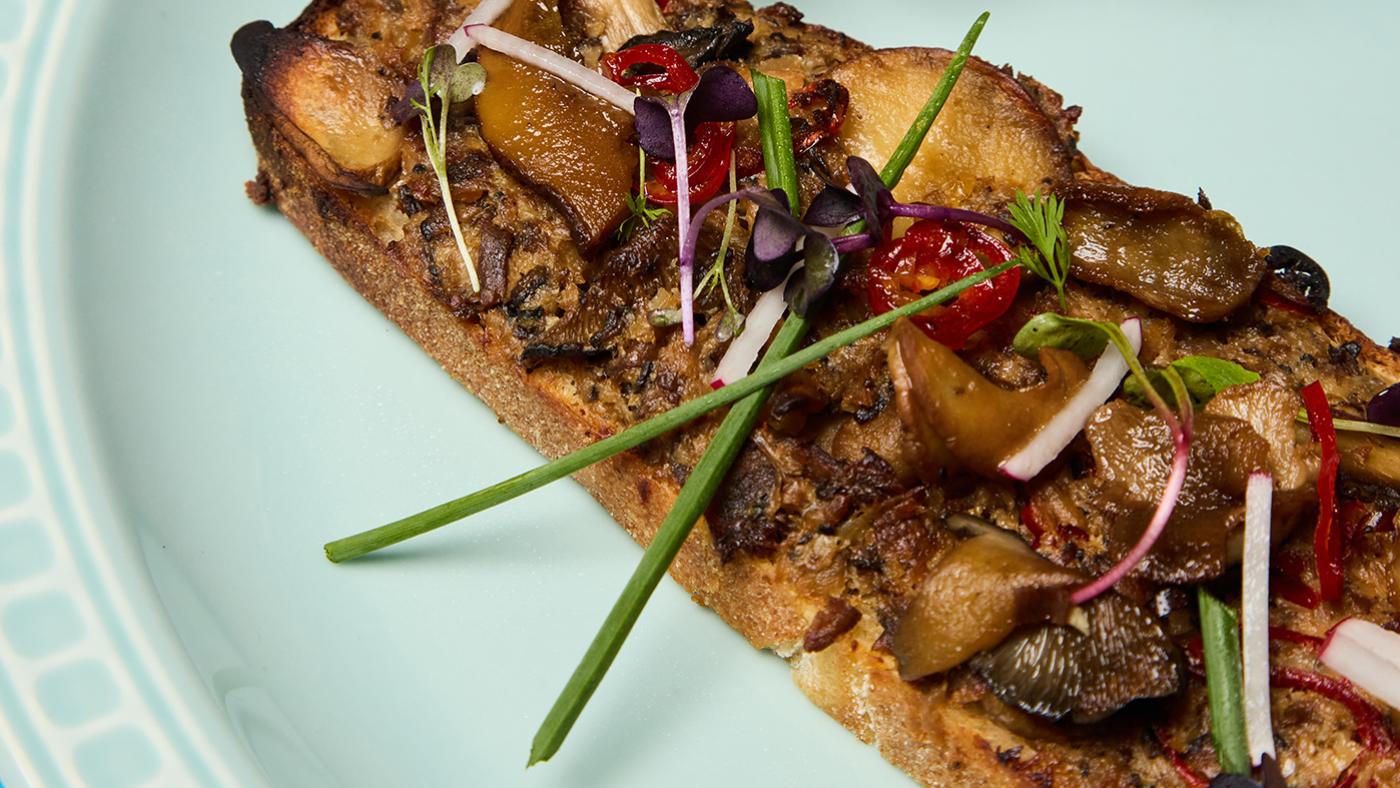Are You Brave Enough to Try Cicada Cracker Jack or Egg Rolls? Chicago Chefs Have Cooked Up Crunchy Cicada Snacks
Maggie Hennessy
June 4, 2024

Get more recipes, food news, and stories by signing up for our Deep Dish newsletter.
Learn more about cicadas at wttw.com/cicadas.
FAFO’s chef and partner Rafa Esparza knew – maybe begrudgingly so – that owning a restaurant whose acronym name stands for F--k Around, Find Out all but required him to make a dish with cicadas once hordes of the insects tunneled up to the surface after 17 long years feeding on tree root sap in the inky darkness beneath northern Illinois.
“People were asking if we were going to do something,” says Esparza, who partners with chefs Anthony Baier and Katharine Urso on the nighttime popup at Moneygun in the West Loop. Not for nothing, either, as FAFO and its creative chefs have dreamt up such oddball delights as Malört grilled cheese and blue-tinted deviled eggs topped with crispy ants.
“People who know me for being me expect that I’m going to act up a little,” Esparza says. “But honestly that’s one of those things where I’ll only do it if I think it can be tasty. Weird or odd is a bonus.”
I was one such voice in this goading chorus, convinced FAFO could make something delicious from these red-eyed bugs the size of human toes – or tater tots, depending on how you see them. In fact, I made a habit out of pestering local chefs as this historic co-emergence of two regional cicada broods drew nearer.
“Technically, cicadas are a local ingredient,” I baited John Dahlstrom, executive chef of the steadfastly Midwestern West Town restaurant, Nettare, while having dinner there in early May. Dahlstrom has a penchant for cooking with alternative animal parts like beef hearts and pigs heads.
“I wonder if they’d be good in an egg roll,” he mused.
A few weeks later, he messaged me with his intentions to do just that. Esparza, meanwhile, briefly debated candying the cicadas and putting them on a salad. Neither chef seemed particularly motivated to put them on the menu, however.
Lobsters’ (Very) Distant Cousins
North Americans have been known to largely recoil from and sensationalize the notion of eating insects – considering them an end-of-the-world rather than everyday ingredient, as they’re seen by billions of people worldwide. Yet for Midwesterners, cicadas and their buzzing songs are as much a fixture of summertime as baseball in the park and the cheery tune of the ice cream truck – if perhaps a bit less, ahem, wholesome to behold to some.
Cicadas are arthropods and very distant insect cousins of shellfish like lobster and shrimp. In food-focused coverage of the mass co-emergence, I’ve seen their connection to the more luxurious crustaceans played up quite a bit, both to entice shellfish lovers and to warn people with shellfish allergies to avoid them, as the Food and Drug Administration has done.
Even so, there’s little data on cicadas, in part because they appear so infrequently. (Citizen scientists are encouraged to upload photos and videos of their cicada sightings to the Cicada Safari app, which helps entomologists unriddle their biology.)
“I wouldn't say they’re closely related to lobsters,” says Tommy McElrath, insect collection manager for the Illinois Natural History Survey at the University of Illinois at Urbana-Champaign’s Prairie Research Institute. “They are both arthropods, so it makes sense you shouldn’t eat them if you have a shellfish allergy. But I don’t think it has been super well-studied, because there aren't a lot of people eating cicadas in North America on a regular basis.”
The nymphs that first emerge from the ground shed their curled exoskeletons to reveal soft, white-winged teneral bodies with a flavor that has been compared to canned white asparagus and shrimp. Within mere hours, they undergo another growth spurt into adults, when their bodies harden and become darker. At this stage they taste nutty and a touch woody with a fatty, underlying note of insecty funk. They’re not a superfood by any stretch, though they contain a nice mix of protein, carbs, fat, and fiber.
“All insects are predominantly made of up a chitin exoskeleton, which is going to have a little nutrition there, mostly fiber, but humans can't digest chitin very well,” McElrath says. Their flight muscles and mating apparati contain a little protein and carbs, and they have enough fat built up from their days feeding on rootlets “to power them until they die,” he says. “They’re very nutritious to wildlife who eat them, like bats, small mammals, and birds.”
Assuming a Crowd-Pleasing Form
McElrath has only eaten cicadas once: on top of a pizza as a graduate student in northern Georgia. After collecting them, he and some friends placed them in the freezer, which puts them to sleep and kills them. They snipped off the cicadas’ wings (which McElrath says can be a little waxy to eat) and removed the legs and pan-fried them in oil and butter until crispy. They dotted a few on top of the pizza and baked it. As McElrath recalls, they tasted a little nutty.
It probably helped that they appeared slightly less buggy without legs or wings. Indeed, accessibility became the main buzzword for our resident chefs, too.
“You want to make eating insects as relatable as possible, which was kind of my thought process behind the egg rolls,” Dahlstrom says. “People don’t want to see bugs when they eat them, so if you can grind them up into a filling, cover them in a wrapper and deep fry them, these things all make them more approachable.”
The cicadas’ screaming, buzzing song may have been notably absent from much of the city this year, but this wasn’t the case in Oak Park, where Dahlstrom’s girlfriend lives and where the two set out on a recent Monday to forage for the insects. The discarded, amber-hued shells piled up four inches deep at the bases of old-growth trees, and cicadas clung in masses to tree trunks and street signs, trilling their mating songs.
Dahlstrom harvested a deli container’s worth, then brought them back to Nettare and froze them. He soaked the cicadas in equal parts apple cider vinegar and water for an hour to clean them. He removed the wings and minced the cicadas with a mixture of mushrooms, green garlic, kohlrabi, more garlic and red onion. The mixture was dusted with Chinese five spice and bound with egg, wrapped in egg roll sheets and deep fried. Nodding cheekily to what lurked inside, Dahlstrom laminated the wrappers with the cicada wings.
The egg rolls sported a satisfyingly guttural crunch; they tasted garlicky, nutty, and piquant, fragrant with clove-y warmth. The insect’s funk only came in quietly at the end. Despite much praise and prodding from me, the egg rolls would not be appearing on Nettare’s regular or tasting menu.
“It’s weird, it’s different, it’s a challenge,” says Dahlstrom of his desire to try this experiment. “I really don't want to make this sound too cathartic, but ever since I started cooking, I always tried to do one little thing behind the veil that makes something taste different but you’re not sure why, like putting anchovy caramel in our pierogis.”
Esparza’s trip to the suburban woods proved far less fruitful than Dahlstrom’s, though not for lack of available product.
“I hadn’t really thought about how skeeved out I was until I saw how big they are,” he says with a laugh. “I was like f--k that, I’m not touching these things. Turns out, I have small, petite coquette energy.”
His friend Emily Nydam, head bartender at Reggie’s, answered his callout on Instagram and turned up last week with a quart-size deli full of the critters that she and her husband harvested from her yard. Grappling with his own disgust with the insects ultimately changed Esparza’s approach to preparing them.
“If I don’t wanna touch them, I’m not gonna wanna eat them,” he says. “I had to figure out a way to ‘sneak myself those veggies,’ if you know what I mean.”
Rather than candying them whole for a salad, he envisioned crushing them into a more poppable form like Cracker Jack, the nostalgic summertime snack (which was born at Chicago’s World’s Fair) befitting of the cicadas’ crunch and nutty flavor profile. Urso and Baier took on most of the handling, of course – arranging the cicadas on sheet trays and putting them in the dehydrator overnight, which rendered them so fragile that they fell apart at the touch of their fingers. They dusted the cicada parts over freshly popped corn and salted peanuts, coated everything in buttery house-made caramel, and baked it. The Cracker Jack tasted salty-sweet and nutty with a satisfying crunch. The cicada pieces mainly lent almondy notes. Only when I popped a head on its own did I get that unmistakable, crittery funk.
Esparza kept FAFO’s followers abreast of the Cracker Jack experiment on the restaurant’s Instagram stories, which evoked some of the expected disgust, alongside fascination and curiosity. (Our boldest readers can try the recipe below.)
“People on our feed were like, ‘That’s wild’ with gross-out emojis,” Esparza says. “But then I got a lot of others like, ‘Yo, how are they? What’s it like?’ And everyone who’s had them f--king loved them, though I always wonder if they’re just being polite.”
Hospitality photographer and self-described picky eater Jonathan Zuluaga stopped by to taste and photograph them shortly before I did. “They’re crunchy and the Cracker Jack really made it easy to eat and enjoy,” he wrote in an Instagram post on May 30.
“It was so good,” he later told me via Instagram DMs. “I was blown away tbh haha.”
In fact, getting such a positive, if unanticipated, response from staff and social media emboldened Esparza to offer Cicada Cracker Jack in addition to a plain batch, both of which hit the menu this week, while fleeting, occasionally polarizing, awe-inspiring supplies last.
“I think this whole need to experiment is not just from a culinary standpoint, you know?” Esparza says. “We’re cohabitating with these [bugs] for now. It’s basic humanity to think about what you can and can’t eat. It’s primal to who we are.”
Cicada Cracker Jack for a Crowd
Recipe by FAFO
Makes 6 quarts
Ingredients
1 quart dehydrated cicadas
1 cup brown sugar
1/4 cup corn syrup
6 Tbsp butter
2 Tbsp water
1/4 tsp salt
1/2 tsp baking soda
2 Tbsp vanilla extract
10 ounces of popcorn, popped
2 cups salted nuts of your choice
Directions
1. After harvesting the cicadas, place them in the freezer for at least a couple hours. Preheat the oven to 150 degrees F. Fit a rack on top of a sheet tray, and arrange the cicadas on it. (Remove the wings before this step if desired). When the oven is preheated, place a wooden spoon or pair of tongs in the door to hold it just cracked open. Dehydrate the cicadas for 4 or 5 hours. Remove and let them cool, then crush them with your fingers. Set aside.
2. In a medium pot over medium heat, combine the brown sugar, corn syrup, butter, water, and salt. Cook for 3 to 5 minutes. Reduce the heat to low, add the baking soda and vanilla, and cook for 1 minute.
3. Place the popcorn, nuts, and about a quarter of the crushed cicadas in a large bowl, and pour over the caramel, tossing well to combine.
4. Preheat the oven to 250 degrees F. Spread the mixture evenly on parchment-lined sheet trays. Bake for 30 minutes, stirring every 10 minutes. About halfway through the bake, add the rest of the cicadas, tossing to combine.
5. Remove and stir once.
You can revisit a story on cicada cuisine from an earlier emergence in this Jay's Chicago segment.








